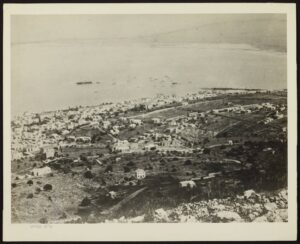After thinking for a long time about the location of the establishment of the technical school, Dr. Paul Nathan decided in favor of Haifa (Jerusalem was also on the agenda). At that time, the Turkish government began to invest in the port of Haifa and the railroads that passed through it, and it was clear that it would become a center for industry, shipping and traffic to other centers on the continent (Damascus and Baghdad). The nature of the Jewish community also influenced the decision: it was small, so Nathan assumed that the Technion would lead to its growth; It was relatively “neutral” – not too religious like in Jerusalem and not Jewish-nationalist like in Jaffa, so conflicts between it and an institution like the Technion were not expected.
Dr. Paul Nathan understood that the best location for the technical institute was Haifa. Although Haifa in the Ottoman period was a small city with 20,000 inhabitants, of which only 2,000 were Jews, it had several advantages: the Turkish government had begun to use Haifa as a major junction for trains that reached the neighboring countries, and it planned a project to expand the port in Haifa. It was clear that these two facts would make Haifa an industrial and transportation center; establishing a technical school would provide jobs for graduates. In addition, the Jewish community in Haifa was small and not driven by political or religious views like other central places such as Jerusalem, which was subject to ultra-Orthodox influence, or Jaffa. A technical school could turn the city into a new Jewish center and promote its development.
In 1908, Paul Nathan received the donation of Wissotzky’s heirs and thus could begin to purchase land. He asked Ephraim Cohen, a representative of “Ezra” in Israel, to look for places in Haifa that would be suitable for the technical school. The representative found some places that Paul Natan personally inspected two months later, and after consulting with Shmuel Pewsner, he chose an area measuring 46 dunams in the neighborhood. Miravan”, which later became known as Hadar Carmel. The area was bought from some Arab and German landowners from the Templar movement. Due to a Turkish law that allowed land registration only in the name of the citizens of the empire, the registration of the land in the name of the German “Ezra” company was postponed for two whole years, until the activist put pressure on the Turkish government with the help of the German ambassador in Istanbul.
In August 1910, the land was finally registered in the name of Dr. James Simon, chairman of the “Ezra” company. Buying the land, brokerage and registration cost 100,000 French francs. Since more money was needed, another fundraiser was held in which more organizations donated. The National Fund for Israel donated 100,000 francs, they demanded and also received representation on the Board of Directors (Schmaryahu Levin and Yechiel Tschlenow). Another group of American Jews led by Jacob Schiff donated $100,000. The donating organizations had different requirements regarding the composition of the management, but in the end, in practice, it was Dr. Paul Natan who managed the group established for the purpose of managing the “Institute for Technical Education” (the first name of the Technion) from its seat in Berlin.
To determine the subjects to be taught at the institute for technical education, Paul Natan consulted with a number of teachers from around Germany. It was decided that the institute for technical education would be of the type called “Technikum” in German. For this reason, “Ezra” decided to call the new technical school Technikum. The school would have two departments, the first is mechanics, and the second is construction and public works. A high school designed to prepare students for the technical school would be established; it would eventually become the Bosmat High School.
For the construction of the technical school, a Jewish architect named Alexander Baerwald was brought from Germany. After Baerwald designed the Technikum buildings, three different licenses were required to start construction – a long and complex process that lasted two years. The delay was caused both by the hostility of the Arab residents and by the inefficiency of the Turkish government. Dr. Schmaryahu Levin was appointed as the manager responsible for the construction on the site, on behalf of the institution’s management. On April 11, 1912, the official ceremony of laying the foundation stone for the Technikum’s main building took place.

